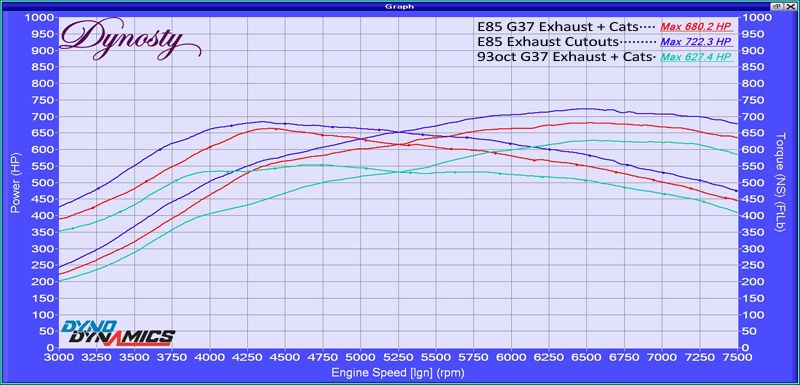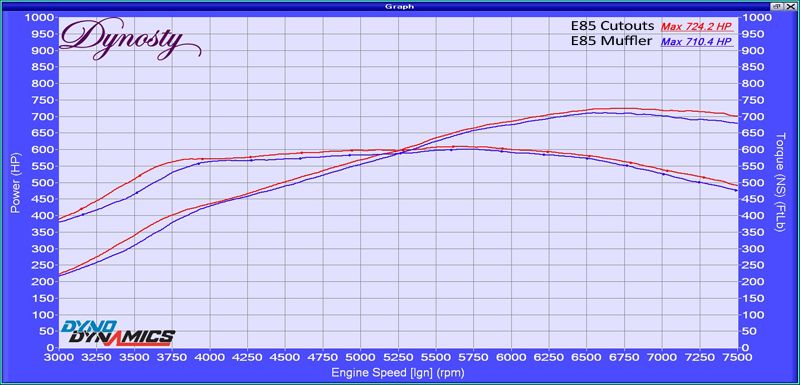why not increase boost to reduce trq drop
#81
New Member
iTrader: (2)
I stumbled across this thread while I was searching for something else but it precisely describes what I was planning to do to overcome a pretty abrupt drop in TQ that starts around 5k rpm which I think is due to the fact that I'm running a cat and an otherwise stock exhaust. As a result I am ending up with a lower HP number than I was expecting. Just wondering if anybody has any more specific experience to add...and maybe even a boost controller to recommend.
#82
New Member
iTrader: (18)
^ post turbo cats will drop power across the rpm range a fixed amount. You lose power everywhere. The graphs below show 200 cell cats and 100 cell cats in series in a dual 3" exhaust with the cats located midway back through the exhaust. When located immediately post-turbo, it was a 60-70 whp loss off the bat with just a single 200 cell cat behind each turbo across the rev range.
These dynographs may be helpful:
e85 maps with boost peaking at 24 psi and dropping to 20 psi at redline (max torque map).

Final e85 dyno curve with ramp up in boost from 17 psi to 25 psi at 6k rpms and up (to help with traction!):

These dynographs may be helpful:
e85 maps with boost peaking at 24 psi and dropping to 20 psi at redline (max torque map).

Final e85 dyno curve with ramp up in boost from 17 psi to 25 psi at 6k rpms and up (to help with traction!):

Last edited by rcdash; 09-30-2013 at 09:06 PM.
#83
New Member
iTrader: (2)
Its hard to argue with those plots that you posted regarding the cats unless there is some other factor not being accounted for. The pressure drop across the cat should be proportional to the flow so I would expect the flow restriction to have more of an effect at high engine speeds.
I like your tq curve with the climbing boost. Thanks for sharing. Mine looks like a triangle.
I like your tq curve with the climbing boost. Thanks for sharing. Mine looks like a triangle.
^ post turbo cats will drop power across the rpm range a fixed amount. You lose power everywhere. The graphs below show 200 cell cats and 100 cell cats in series in a dual 3" exhaust with the cats located midway back through the exhaust. When located immediately post-turbo, it was a 60-70 whp loss off the bat with just a single 200 cell cat behind each turbo across the rev range.
These dynographs may be helpful:
e85 maps with boost peaking at 24 psi and dropping to 20 psi at redline (max torque map).

Final e85 dyno curve with ramp up in boost from 17 psi to 25 psi at 6k rpms and up (to help with traction!):

These dynographs may be helpful:
e85 maps with boost peaking at 24 psi and dropping to 20 psi at redline (max torque map).

Final e85 dyno curve with ramp up in boost from 17 psi to 25 psi at 6k rpms and up (to help with traction!):

#85
New Member
iTrader: (2)

I finally made a run on a chassis dyno and the shape of the tq curve was basically the same. The mustang dyno just showed higher numbers and a shift of the curve to the left.
#86
raise your boost at 5000-redline rpms up another 5-10psi
Alot of GTR tuners are starting to tune like that. progressively increasing the boost to redline.
BUT, you can only do this if your turbo can flow enough at those rpms. RcDash and myself have more than enough turbo to do so.
Alot of GTR tuners are starting to tune like that. progressively increasing the boost to redline.
BUT, you can only do this if your turbo can flow enough at those rpms. RcDash and myself have more than enough turbo to do so.
#87
New Member
iTrader: (2)
raise your boost at 5000-redline rpms up another 5-10psi
Alot of GTR tuners are starting to tune like that. progressively increasing the boost to redline.
BUT, you can only do this if your turbo can flow enough at those rpms. RcDash and myself have more than enough turbo to do so.
Alot of GTR tuners are starting to tune like that. progressively increasing the boost to redline.
BUT, you can only do this if your turbo can flow enough at those rpms. RcDash and myself have more than enough turbo to do so.
#88
you just need a controller that can increase duty based on rpm.
http://tunertools.com/gizzmo-electro...st-levels.html
http://www.turbosmartusa.com/product/e-boost-2
pretty much any electronic boost controller will work since you have to define the duty cycle at given rpm increments. instead of keeping the duty cycle flat, keep raising it up at the point on yoru dyno when the torque starts to lay over.
http://tunertools.com/gizzmo-electro...st-levels.html
http://www.turbosmartusa.com/product/e-boost-2
pretty much any electronic boost controller will work since you have to define the duty cycle at given rpm increments. instead of keeping the duty cycle flat, keep raising it up at the point on yoru dyno when the torque starts to lay over.
Thread
Thread Starter
Forum
Replies
Last Post
Lt_Ballzacki
Brakes & Suspension
39
08-06-2021 06:19 AM
Gruppe-S
Body Interior
13
05-16-2016 10:42 PM




